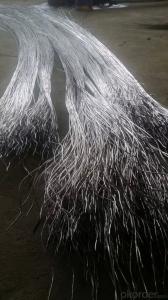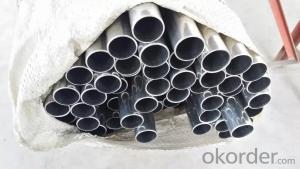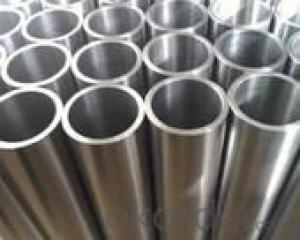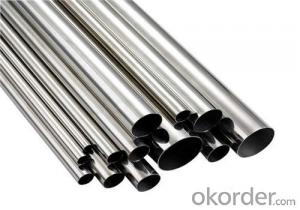High precision 316l stainless seamless steel capillary tube
- Loading Port:
- Shanghai
- Payment Terms:
- TT OR LC
- Min Order Qty:
- 50 m.t.
- Supply Capability:
- 10000 m.t./month
OKorder Service Pledge
Quality Product, Order Online Tracking, Timely Delivery
OKorder Financial Service
Credit Rating, Credit Services, Credit Purchasing
You Might Also Like
High precision 316l stainless seamless steel capillary tube
Our advantages:
1.High quality and Competitive price
2.Professional service ,quick delivery
3.High luster,elegance,rigidity and durability
Specification:
| Description | High precision 316l stainless seamless steel capillary tube | ||||
| Grade | 310S,309S,316,316L,321,347,304,304L,201,301 310S(1.4845); 317L(1.1138); 321H(1.4878); 304H(1.4948), etc | ||||
| Standard | China | Japan | the United States | EU | Germany |
| GB | JIS | ASTM | BSEN | DIN | |
| GB/T14975/14976/13296 | JISG3459/3463 | ASTM A269/A312/A213/A511/A789/A790 | EN10216-5 | DIN17456/17458 | |
| Surface | Pickling,annealing,polishing,bright,sand blast,hair line,etc | ||||
| Size | O. D | 0.3mm~10mm | |||
| W. T | 0.08mm~1.5mm | ||||
| Length | 5mm-8000mm or Customize | ||||
| Advantages | 1. Reasonable price with excellent quality. | ||||
| 2. OEM Service Offered, Non-standard products can be ordered. | |||||
| 3. Durable in use: High precision. Smooth and Bright surface. | |||||
| 4. Excellent and high quality control. | |||||
| 5. Convenient transportation: Our company is beside the express way from Shanghai to Nanjing, it is 226km away from PuDong International Airport and 261km away from Yangshan Deepwater Port. | |||||
| Test | NTD(Ultrasonic test, Eddy Current test), Mechanical Test(Tension Test, Flaring Test, Flattening Test, Hardness Test, Intergranular Corrosion Test, Hydraulic test), Metal Test(Metallographic Analysis, Impact Test-High/low temperature), Chemical Analysis( Photoelectric Emission Spectroscopic) | ||||
| Applications | petroleum, chemical, pharmaceutical, food, machinery, aerospace, construction, military, hardware, gas boilers, plumbing devices, ships, power plants | ||||
| Delivery | 15-45 days after receiving deposit | ||||
| Origin | China | Payment terms | FOB, CFR, CIF | ||
| Package | Bundled with knitted plastic bag, wooden cases or according to customers' request. | ||||
| Service | 1. We accept OEM and sample orders to fulfill the clients’ requests. 2. If you have any problems during use. We spare no efforts in resolving your troubles. | ||||

- Q: Can stainless steel strips be bent or formed?
- Yes, stainless steel strips can be bent or formed. Stainless steel has excellent formability and can be easily bent, shaped, or formed into various configurations without compromising its strength or structural integrity.
- Q: Can stainless steel strips be used for heat sinks?
- Yes, stainless steel strips can be used for heat sinks. Stainless steel has good thermal conductivity, which allows it to transfer heat efficiently. Additionally, stainless steel is resistant to corrosion, making it a durable option for heat sink applications. However, it is important to note that stainless steel has lower thermal conductivity compared to materials like copper or aluminum, which are commonly used for heat sinks. Therefore, stainless steel strips may not be as effective as other materials in dissipating heat in high-power applications.
- Q: What is the fracture toughness of stainless steel strips?
- The fracture toughness of stainless steel strips can vary depending on the specific grade and composition of the stainless steel. Generally, stainless steel has high fracture toughness due to its excellent resistance to cracking and ability to absorb energy before fracturing.
- Q: Are stainless steel strips resistant to pitting?
- Yes, stainless steel strips are generally resistant to pitting. Pitting corrosion is a type of localized corrosion that causes small holes or pits to form on the surface of metals, including stainless steel. However, stainless steel has a high resistance to pitting due to its chromium content. Chromium forms a passive protective layer on the surface of stainless steel, which helps to prevent the metal from corroding. Additionally, stainless steel is often alloyed with other elements such as molybdenum and nickel, which further enhance its resistance to pitting corrosion. Therefore, stainless steel strips are commonly used in applications where corrosion resistance is crucial, such as in the construction, automotive, and food processing industries.
- Q: How do stainless steel strips handle exposure to alkalis?
- Due to their strong resistance to alkalis, stainless steel strips are an ideal choice for applications that require exposure to such substances. The presence of chromium in stainless steel creates a protective layer on the surface, called a passive film, which acts as a barrier against corrosion and chemical attacks. This passive film effectively blocks alkalis from penetrating the steel, thereby safeguarding it against potential damage. Moreover, stainless steel's exceptional corrosion resistance and durability enable it to withstand prolonged exposure to alkalis without deterioration or loss of structural integrity. As a result, stainless steel strips are a dependable and enduring material for a wide range of industrial and commercial uses that involve alkalis.
- Q: Can stainless steel strips be bent or shaped?
- Yes, stainless steel strips can be bent or shaped. Stainless steel is known for its excellent flexibility and ductility, allowing it to be easily formed into various shapes and angles.
- Q: Can stainless steel strips be formed into complex shapes?
- Yes, stainless steel strips can be formed into complex shapes through various processes such as bending, rolling, and stamping.
- Q: How do stainless steel strips perform in cryogenic conditions?
- Stainless steel strips are renowned for their outstanding performance in cryogenic conditions. The remarkable structural integrity and dimensional stability of stainless steel are maintained even in extremely low temperatures, thanks to its low thermal expansion coefficient. This characteristic renders stainless steel strips highly suitable for use in cryogenic environments, where alternative materials may become brittle or lose their properties. Moreover, stainless steel possesses remarkable corrosion resistance, a critical feature in cryogenic conditions where moisture and condensation can occur. The elevated levels of chromium in stainless steel create a protective oxide layer, preventing corrosion and ensuring the material's durability and performance. Furthermore, stainless steel strips exhibit commendable mechanical properties, even in low temperatures. They retain their strength and ductility, enabling them to endure the stresses and strains encountered in cryogenic environments. Consequently, stainless steel is an ideal option for applications in aerospace, medical, and scientific equipment that operate under cryogenic conditions. In conclusion, stainless steel strips exhibit exceptional performance in cryogenic conditions due to their low thermal expansion coefficient, corrosion resistance, and mechanical properties. They offer reliability, durability, and longevity, making them the preferred material choice for various industries that necessitate materials capable of withstanding extreme cold temperatures.
- Q: Can stainless steel strips be used in high-temperature environments?
- Yes, stainless steel strips can be used in high-temperature environments. Stainless steel is known for its excellent heat resistance properties, making it suitable for applications that involve exposure to high temperatures. The specific grade of stainless steel used and the temperature range will determine the level of heat resistance. However, most stainless steel grades can withstand temperatures up to 1000°C (1832°F) without losing their mechanical properties. Stainless steel's ability to resist oxidation and corrosion also contributes to its suitability for high-temperature environments.
- Q: Are stainless steel strips suitable for electrical applications?
- Yes, stainless steel strips are suitable for electrical applications. Stainless steel has excellent electrical conductivity and is resistant to corrosion, making it a reliable choice for various electrical components and systems.
Send your message to us
High precision 316l stainless seamless steel capillary tube
- Loading Port:
- Shanghai
- Payment Terms:
- TT OR LC
- Min Order Qty:
- 50 m.t.
- Supply Capability:
- 10000 m.t./month
OKorder Service Pledge
Quality Product, Order Online Tracking, Timely Delivery
OKorder Financial Service
Credit Rating, Credit Services, Credit Purchasing
Similar products
Hot products
Hot Searches
Related keywords




























